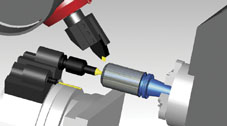 In the best of all worlds, the part model created by the original designer is used directly throughout the entire manufacturing process. If communication between the designer and the customer uses the same part model, then the chance of miscommunication and incorrect or overlooked changes is reduced. The same is true between the designer and the machine shop, between the machine shop and its suppliers, between the customer and its sales forces, and ultimately between the customer and their customers. When conversion or translation of an original part model is done to accommodate the needs of a particular software package, that is where the time and the cost involved increase, and opportunities for miscommunication and other mistakes increase proportionally. What this means is that if machine shop programmers have to convert, and rebuild customer part models, they run up unnecessary costs and they increase the chances that more costly mistakes will be made because of miscommunications or programmer errors. Some CAM packages automatically convert a part model into their format, and claim to be 100 percent accurate in associating back to the original model. Even if that is true, it still means that at least two models for the same part must be maintained instead of one. If any changes become necessary, then both models must be fully maintained so that all subsequent actions based on the part model remain accurate. That may not seem very significant until you think of the other tasks that a part誷 model can be used for besides machining.
In the best of all worlds, the part model created by the original designer is used directly throughout the entire manufacturing process. If communication between the designer and the customer uses the same part model, then the chance of miscommunication and incorrect or overlooked changes is reduced. The same is true between the designer and the machine shop, between the machine shop and its suppliers, between the customer and its sales forces, and ultimately between the customer and their customers. When conversion or translation of an original part model is done to accommodate the needs of a particular software package, that is where the time and the cost involved increase, and opportunities for miscommunication and other mistakes increase proportionally. What this means is that if machine shop programmers have to convert, and rebuild customer part models, they run up unnecessary costs and they increase the chances that more costly mistakes will be made because of miscommunications or programmer errors. Some CAM packages automatically convert a part model into their format, and claim to be 100 percent accurate in associating back to the original model. Even if that is true, it still means that at least two models for the same part must be maintained instead of one. If any changes become necessary, then both models must be fully maintained so that all subsequent actions based on the part model remain accurate. That may not seem very significant until you think of the other tasks that a part誷 model can be used for besides machining. Start with the designer.
Look for the software available, which tells a designer if features of the part he just designed are unnecessarily expensive to machine. For example, a small radius filet at the bottom of a three-inch hole may need a $100 EDM operation to produce, while a slightly larger radius could be done at a fraction of that cost. Knowing that gives the designer an opportunity to take costs out of making that part, and eliminates the need for the machine shop operator to educate the designer and the customer on why making that hole as designed is so expensive. And where does the quality control system get its measurement and tolerance information? Where does the ISO reporting software look for data? Which model is used to make workholding jigs and fixtures? How about automated package design and manufacturing after the part is made? Which model is usedAir Jordan VI 6 Shoes













